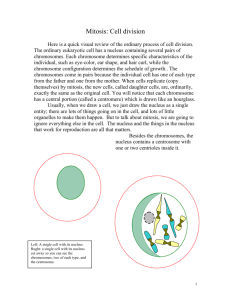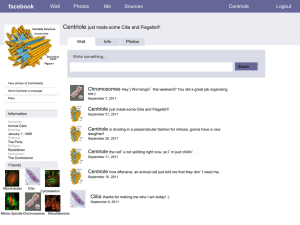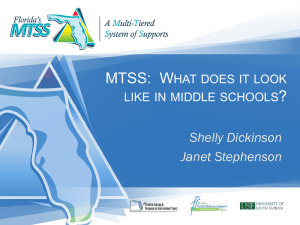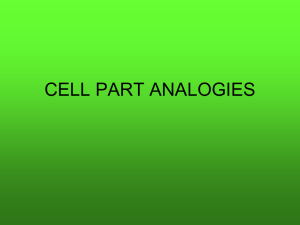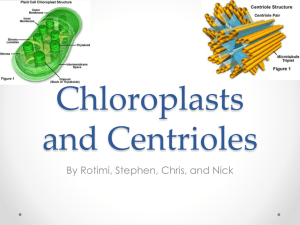Mechanism limiting centrosome duplication to once per cell cycle Meng-Fu Bryan Tsou
advertisement
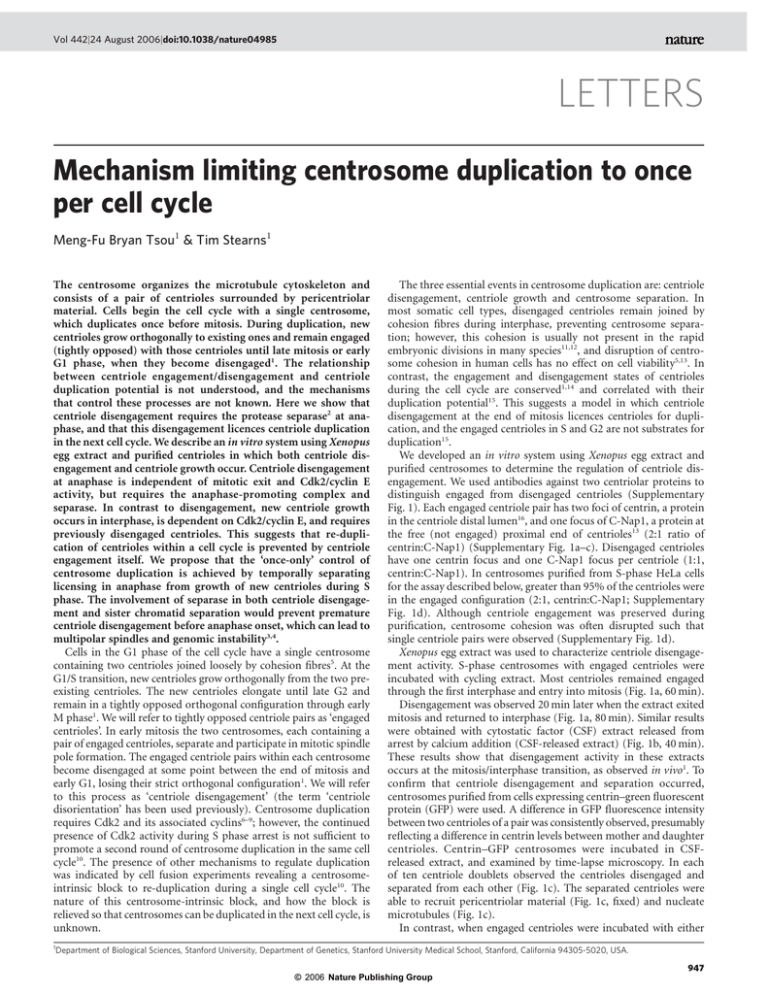
Vol 442|24 August 2006|doi:10.1038/nature04985 LETTERS Mechanism limiting centrosome duplication to once per cell cycle Meng-Fu Bryan Tsou1 & Tim Stearns1 The centrosome organizes the microtubule cytoskeleton and consists of a pair of centrioles surrounded by pericentriolar material. Cells begin the cell cycle with a single centrosome, which duplicates once before mitosis. During duplication, new centrioles grow orthogonally to existing ones and remain engaged (tightly opposed) with those centrioles until late mitosis or early G1 phase, when they become disengaged1. The relationship between centriole engagement/disengagement and centriole duplication potential is not understood, and the mechanisms that control these processes are not known. Here we show that centriole disengagement requires the protease separase2 at anaphase, and that this disengagement licences centriole duplication in the next cell cycle. We describe an in vitro system using Xenopus egg extract and purified centrioles in which both centriole disengagement and centriole growth occur. Centriole disengagement at anaphase is independent of mitotic exit and Cdk2/cyclin E activity, but requires the anaphase-promoting complex and separase. In contrast to disengagement, new centriole growth occurs in interphase, is dependent on Cdk2/cyclin E, and requires previously disengaged centrioles. This suggests that re-duplication of centrioles within a cell cycle is prevented by centriole engagement itself. We propose that the ‘once-only’ control of centrosome duplication is achieved by temporally separating licensing in anaphase from growth of new centrioles during S phase. The involvement of separase in both centriole disengagement and sister chromatid separation would prevent premature centriole disengagement before anaphase onset, which can lead to multipolar spindles and genomic instability3,4. Cells in the G1 phase of the cell cycle have a single centrosome containing two centrioles joined loosely by cohesion fibres5. At the G1/S transition, new centrioles grow orthogonally from the two preexisting centrioles. The new centrioles elongate until late G2 and remain in a tightly opposed orthogonal configuration through early M phase1. We will refer to tightly opposed centriole pairs as ‘engaged centrioles’. In early mitosis the two centrosomes, each containing a pair of engaged centrioles, separate and participate in mitotic spindle pole formation. The engaged centriole pairs within each centrosome become disengaged at some point between the end of mitosis and early G1, losing their strict orthogonal configuration1. We will refer to this process as ‘centriole disengagement’ (the term ‘centriole disorientation’ has been used previously). Centrosome duplication requires Cdk2 and its associated cyclins6–9; however, the continued presence of Cdk2 activity during S phase arrest is not sufficient to promote a second round of centrosome duplication in the same cell cycle10. The presence of other mechanisms to regulate duplication was indicated by cell fusion experiments revealing a centrosomeintrinsic block to re-duplication during a single cell cycle10. The nature of this centrosome-intrinsic block, and how the block is relieved so that centrosomes can be duplicated in the next cell cycle, is unknown. 1 The three essential events in centrosome duplication are: centriole disengagement, centriole growth and centrosome separation. In most somatic cell types, disengaged centrioles remain joined by cohesion fibres during interphase, preventing centrosome separation; however, this cohesion is usually not present in the rapid embryonic divisions in many species11,12, and disruption of centrosome cohesion in human cells has no effect on cell viability5,13. In contrast, the engagement and disengagement states of centrioles during the cell cycle are conserved1,14 and correlated with their duplication potential15. This suggests a model in which centriole disengagement at the end of mitosis licences centrioles for duplication, and the engaged centrioles in S and G2 are not substrates for duplication15. We developed an in vitro system using Xenopus egg extract and purified centrosomes to determine the regulation of centriole disengagement. We used antibodies against two centriolar proteins to distinguish engaged from disengaged centrioles (Supplementary Fig. 1). Each engaged centriole pair has two foci of centrin, a protein in the centriole distal lumen16, and one focus of C-Nap1, a protein at the free (not engaged) proximal end of centrioles13 (2:1 ratio of centrin:C-Nap1) (Supplementary Fig. 1a–c). Disengaged centrioles have one centrin focus and one C-Nap1 focus per centriole (1:1, centrin:C-Nap1). In centrosomes purified from S-phase HeLa cells for the assay described below, greater than 95% of the centrioles were in the engaged configuration (2:1, centrin:C-Nap1; Supplementary Fig. 1d). Although centriole engagement was preserved during purification, centrosome cohesion was often disrupted such that single centriole pairs were observed (Supplementary Fig. 1d). Xenopus egg extract was used to characterize centriole disengagement activity. S-phase centrosomes with engaged centrioles were incubated with cycling extract. Most centrioles remained engaged through the first interphase and entry into mitosis (Fig. 1a, 60 min). Disengagement was observed 20 min later when the extract exited mitosis and returned to interphase (Fig. 1a, 80 min). Similar results were obtained with cytostatic factor (CSF) extract released from arrest by calcium addition (CSF-released extract) (Fig. 1b, 40 min). These results show that disengagement activity in these extracts occurs at the mitosis/interphase transition, as observed in vivo1. To confirm that centriole disengagement and separation occurred, centrosomes purified from cells expressing centrin–green fluorescent protein (GFP) were used. A difference in GFP fluorescence intensity between two centrioles of a pair was consistently observed, presumably reflecting a difference in centrin levels between mother and daughter centrioles. Centrin–GFP centrosomes were incubated in CSFreleased extract, and examined by time-lapse microscopy. In each of ten centriole doublets observed the centrioles disengaged and separated from each other (Fig. 1c). The separated centrioles were able to recruit pericentriolar material (Fig. 1c, fixed) and nucleate microtubules (Fig. 1c). In contrast, when engaged centrioles were incubated with either Department of Biological Sciences, Stanford University, Department of Genetics, Stanford University Medical School, Stanford, California 94305-5020, USA. © 2006 Nature Publishing Group 947 LETTERS NATURE|Vol 442|24 August 2006 interphase-arrested extract or CSF-arrested extract no disengagement was observed (Fig. 1d). To confirm that this reflected a failure of disengagement rather than disengagement followed by new centriole growth, centrin–GFP centrosomes were used. In this case, any newly formed centrioles would be GFP-negative, because the extract lacks soluble centrin–GFP. Only doublets in which both centrioles were GFP-positive were observed (Fig. 1d), indicating lack of centriole disengagement and of new centriole growth from engaged centrioles. The combination of CSF-released extract with centrin–GFPlabelled centrioles provided a rapid assay to probe the requirements for centriole disengagement. We tested whether disengagement requires Cdk2/cyclin E, a cell cycle kinase required for centrosome duplication6–9. The Cdk2 inhibitor D34Xic1 blocked mitotic entry (Fig. 2), as reported17, but had no effect on centriole disengagement (Fig. 2). It is important to distinguish the disengagement activity described here from the previously reported Cdk2-dependent centriole separation activity in interphase Xenopus egg extract7. The previous work used G1 centrosomes with disengaged centrioles7, and the activity observed was probably the breakage of centrosome cohesion, which is distinct from centriole disengagement. We next tested whether disengagement requires mitotic exit and entry into interphase. Non-degradable D90 cyclin B was used to block mitotic exit in CSF-released extract (anaphase extract18,19). The extract remained in mitosis, as assayed by sperm chromatin morphology (Fig. 2), but centriole disengagement occurred by 40 min after calcium addition. Thus, centriole disengagement requires neither inactivation of Cdk1 activity nor an interphase-specific activity. Addition of calcium to a CSF extract results in activation of the anaphase-promoting complex (APC). We tested whether centriole disengagement requires APC by adding an APC peptide inhibitor18 to CSF extract before the addition of centrioles and calcium. APC inhibition blocked centriole disengagement, whereas a mutant control peptide had no effect (Fig. 2), indicating that APC is required for centriole disengagement. A key target of APC activity is separase, a protease that cleaves the cohesin complex at anaphase to facilitate the separation of sister chromatids2. Two pathways inhibit the activity of separase before anaphase: securin20 and high levels of Cdk1/cyclin B19; both are released at anaphase by APC activation. We tested the involvement of separase in centriole disengagement in two ways. First, we used an excess of D90 cyclin B, which inhibits separase but not APC19. A twofold increase in added D90 cyclin B blocked centriole disengagement (Fig. 3a). This result indicates that APC is not directly responsible for disengagement, because it is still active in these extracts19, and is consistent with a requirement for separase. To test further the role of separase in centriole disengagement, a nondegradable form of Xenopus securin (Xsecurindm) was used to inhibit separase. Incubation of Xsecurindm with extract as previously described20 efficiently blocked separase activity but otherwise allowed cell cycle progression (Fig. 3b). Both chromatid separation and centriole disengagement were blocked in Xsecurindm-treated extract (Fig. 3b), whereas both proceeded in mock-treated extract. Consistent with the failure of disengagement, the centriole doublets were contained within a single focus of pericentriolar material (Fig. 3b, fixed). This suggests that separase activation is required for centriole disengagement as well as sister chromatid separation, both of which occur at anaphase. We used the centriole disengagement assay to examine the relationship between disengagement and centriole growth. Engaged centrioles were incubated in CSF-released extract as in Fig. 1b but the time in extract was increased to allow for centriole growth. We found Figure 1 | Centriole disengagement activity is present in late mitosis. a, b, d, S-phase centrosomes with engaged centrioles (non-labelled or centrin–GFP-labelled) and sperm nuclei were incubated with extract for the indicated times. At each time point, centriole configuration was determined (n ¼ 100 centrosomes) with anti-centrin (green) and anti-C-Nap1 (red) antibodies. Anti-C-Nap1 antibodies react specifically with human C-Nap1 (not shown), thus only the input human centrosomes are labelled. Cell cycle stage was determined by the morphology of sperm DNA stained with Hoechst 33342 (blue). Centrin–GFP-labelled centrioles were visualized directly by fluorescent microscopy. The difference in centrin–GFP intensity between two centrioles of a pair was consistently observed, presumably reflecting a difference in centrin levels between mother and daughter centrioles (indicated with yellow arrows). The percentage of doublets is shown in the upper left of each panel; percentage of singlets in lower right. c, Time-lapse imaging of centriole disengagement and separation in CSF-released extract, visualized by centrin–GFP fluorescence. A sample of the reaction was also fixed and stained with anti-GFP (green) and anti-gtubulin (red) antibodies (fixed). Microtubule nucleation from disengaged centrioles in extract is shown with centrin–GFP (green) and rhodaminelabelled tubulin (red) as indicated (bottom panel). Scale bars: 1 mm. 948 © 2006 Nature Publishing Group LETTERS NATURE|Vol 442|24 August 2006 that centrioles became disengaged as above, followed by formation of new centrioles, so that at the subsequent prophase (90 min) most singlets had again become doublets (Fig. 4a). Inhibiting Cdk2/cyclin E with D34Xic1 blocked centriole growth but not centriole disengagement (Fig. 4a), indicating that growth and disengagement are separable activities. We have shown that centriole disengagement activity is present at anaphase (Figs 1a, b, 2 and 3b), that centriole growth activity is present during interphase (Fig. 4a), and that centriole growth does not occur from engaged centrioles (Fig. 1a, c). This suggests that centriole growth can only occur from disengaged centrioles. To test this, engaged centrioles were allowed to disengage in CSF-released extract, then diluted tenfold into cycling extract. In contrast to the results with engaged centrioles (Fig. 1a, c), new daughter centrioles grew from these disengaged mothers during the first interphase (Fig. 4b). These newly duplicated centriole doublets became disengaged again at the following anaphase (Fig. 4b, 80 min). This result indicates that centriole disengagement is a prerequisite for centriole growth, and therefore that the engaged state of centrioles after duplication is a mechanism for the centrosome-intrinsic block to re-duplication. We have described a mechanism that limits centrosome duplication to once per cell cycle. This control is achieved by separating centriole duplication into two distinct phases (Supplementary Fig. 2). First, centrioles are disengaged during anaphase—dependent on Figure 2 | Molecular requirements for centriole disengagement. Engaged S-phase centrioles purified from HeLa cells expressing centrin–GFP and sperm nuclei were incubated with CSF extracts pre-treated with reagents as indicated, and calcium was added to release CSF arrest (time after calcium addition is shown). DNA was stained with Hoechst 33342 (blue). Centrioles at each time point (n ¼ 100) were visualized directly by fluorescence microscopy. Yellow arrows indicate daughter centrioles. The percentage of doublets is shown in the upper left of each panel; percentage of singlets in lower right. The final concentrations of proteins/peptides added in the extract are: 0.5 mg ml21 D34Xic1; 0.04 mg ml21 D90 cyclin B; 0.25 mg ml21 D-box peptide; 0.25 mg ml21 D-box mutant peptide. Scale bar: 1 mm. separase activity—which licences them for duplication in the subsequent interphase. Second, the disengaged centrioles support the growth of new centrioles in interphase—dependent on Cdk2/cyclin E activity. Newly duplicated centrioles are engaged, and disengagement activity is absent in interphase, preventing a second round of Figure 3 | Separase is essential for centriole disengagement. a, CSF extract was pre-treated with excess D90 cyclin B (0.08 mg ml21). S-phase centrosomes containing centrin–GFP-labelled centrioles were incubated and assayed as described in Fig. 2. Yellow arrows indicate daughter centrioles. b, Chromatid separation and centriole disengagement assays were performed in BSA-treated or Xsecurindm-treated extract. Images show the Hoechst-33342-stained chromosomes (blue) and rhodamine-labelled mitotic spindles (red) at times after metaphase release (min). The percentage of spindles at metaphase for each time point (n ¼ 25 spindles) is indicated. In the centriole disengagement assay, centrin–GFP-labelled centrioles were used for direct visualization by fluorescence microscopy. Yellow arrows indicate daughter centrioles. A sample of the reaction was also fixed and stained with anti-GFP (green) and anti-g-tubulin (red) antibodies (fixed, 40 min). The percentage of doublets is shown in the upper left of each panel; percentage of singlets in lower right. The white and red scale bars represent 1 mm and 10 mm, respectively. © 2006 Nature Publishing Group 949 LETTERS NATURE|Vol 442|24 August 2006 Figure 4 | Centriole disengagement is required for centriole growth. a, Sperm nuclei and S-phase centrosomes containing engaged centrioles were incubated with CSF extracts pre-treated with buffer or D34Xic1 (0.5 mg ml21), and calcium was added to release CSF arrest (time after calcium addition is shown). DNA is stained with Hoechst 33342 (blue). Input human centrosomes were visualized by anti-centrin (upper left of each panel, green in merged image) and anti-human pericentrin (upper right, red in merged image) antibodies at the indicated time points (n ¼ 100). b, Centrosomes treated previously with CSF-released extract, thus containing disengaged centrioles, were incubated with cycling extract for the times indicated. Centrosomes at each time point (n ¼ 50) were visualized by anti-centrin (left of each panel, green in merged image) and anti-human pericentrin (middle of each panel, red in merged image) antibodies. The percentage of doublets is shown in the upper left of the first panel of each time point; percentage of singlets in lower right. Scale bars: 1 mm. duplication in the same cycle (Supplementary Fig. 2). This strategy for controlling centrosome duplication closely resembles that for DNA replication21; for both processes it is the absence of licensing activity until the end of mitosis that limits replication/duplication to once per cell cycle. Our results suggest that centriole disengagement requires the activity of separase, a protease previously shown to release sisterchromatid cohesion in anaphase2. This remarkably parsimonious design temporally links these two essential events in the cell cycle. The timing of these events is critical: premature sister chromatid separation results in mis-segregation of chromosomes2, and premature centriole disengagement potentially leads to multipolar spindles, also a source of abnormal divisions3,4. Our experiments made use of the simple embryonic cell cycle; however, recent results also suggest a link between premature activation of separase and centriole disengagement in somatic cells. For example, the Tax viral oncoprotein prematurely activates APC and causes multipolar spindles22,23; we suggest that this might occur by premature APC-mediated activation of separase. Similarly, the premature centriole disengagement that occurs in some cells entering mitosis with DNA damage3 might be explained by separase activation that accompanies DNA repair24. We note that we have not yet directly tested the role of separase by depletion from extract or cells, and it is formally possible that the two mechanistically distinct treatments used here block an activity other than separase required for disengagement. Direct tests are complicated by the pleiotropic phenotype associated with separase depletion25. Recent development of conditional null mutations in mouse26,27 might allow a direct test, but will require more detailed experiments than those presented. Many human cancers exhibit centrosome amplification, which is strongly correlated with genomic instability28. The simple model for centrosome duplication described here serves as a framework upon which other regulatory modules can be added in somatic cells, and it will be of interest to determine how the mechanism is subverted in cancer cells. 950 METHODS Details of cell culture, antibodies, centrosome isolation and Xenopus extract preparation are described in Supplementary Information. In vitro centriole disengagement assay. Forty microlitres of the CSF extract was incubated with 1 ml purified centrosomes (approximately 2.5 £ 104) at 23 8C for 5–10 min, and calcium was added to trigger centriole disengagement. Where indicated, extract was incubated with added components for 30 min on ice or at 23 8C before the addition of centrosomes. Reactions were stopped at the indicated time after calcium addition by the addition of 1 ml of 0.5 M EDTA, and frozen in liquid N2. To assay DNA morphology, sperm nuclei were added, fixed at time points, and labelled with Hoechst 33258. The presence or absence of sperm chromatin had no effect on the centriole disengagement activity. To immunostain centrosomes, 1–2 ml of extract was squashed between slide and coverslip (12 mm round) and frozen by immersion in liquid N2 for 30 s. The slide was removed from liquid N2 and the coverslip removed by prying off with a single-edge razor blade, leaving a thin layer of frozen extract. These samples were fixed in 100% methanol for 5 min at 220 8C, followed by re-hydration in PBS. © 2006 Nature Publishing Group LETTERS NATURE|Vol 442|24 August 2006 After incubation with primary and secondary antibodies, samples were dehydrated in 100% methanol, and cleared and mounted in benzyl alcohol/benzyl benzoate clearing solution as described previously11. Note that anti-human C-Nap1 and anti-human pericentrin antibodies react specifically with the human proteins, and not Xenopus (not shown), thus only the input human centrosomes are labelled. In experiments in which centrin–GFP-labelled centrosomes were used, centrioles were visualized directly using fluorescence microscopy. Received 18 March; accepted 19 June 2006. Published online 19 July 2006. 1. 2. 3. 4. 5. 6. 7. 8. 9. 10. 11. 12. 13. 14. 15. Kuriyama, R. & Borisy, G. G. Centriole cycle in Chinese hamster ovary cells as determined by whole-mount electron microscopy. J. Cell Biol. 91, 814–-821 (1981). Nasmyth, K., Peters, J. M. & Uhlmann, F. Splitting the chromosome: cutting the ties that bind sister chromatids. Science 288, 1379–-1385 (2000). Hut, H. M. et al. Centrosomes split in the presence of impaired DNA integrity during mitosis. Mol. Biol. Cell 14, 1993–-2004 (2003). McDermott, K. M. et al. p16(INK4a) prevents centrosome dysfunction and genomic instability in primary cells. PLoS Biol. 4, e51 (2006). Bahe, S., Stierhof, Y. D., Wilkinson, C. J., Leiss, F. & Nigg, E. A. Rootletin forms centriole-associated filaments and functions in centrosome cohesion. J. Cell Biol. 171, 27–-33 (2005). Hinchcliffe, E. H., Li, C., Thompson, E. A., Maller, J. L. & Sluder, G. Requirement of Cdk2-cyclin E activity for repeated centrosome reproduction in Xenopus egg extracts. Science 283, 851–-854 (1999). Lacey, K. R., Jackson, P. K. & Stearns, T. Cyclin-dependent kinase control of centrosome duplication. Proc. Natl Acad. Sci. USA 96, 2817–-2822 (1999). Matsumoto, Y., Hayashi, K. & Nishida, E. Cyclin-dependent kinase 2 (Cdk2) is required for centrosome duplication in mammalian cells. Curr. Biol. 9, 429–-432 (1999). Meraldi, P., Lukas, J., Fry, A. M., Bartek, J. & Nigg, E. A. Centrosome duplication in mammalian somatic cells requires E2F and Cdk2-cyclin A. Nature Cell Biol. 1, 88–-93 (1999). Wong, C. & Stearns, T. Centrosome number is controlled by a centrosomeintrinsic block to reduplication. Nature Cell Biol. 5, 539–-544 (2003). Gard, D. L., Hafezi, S., Zhang, T. & Doxsey, S. J. Centrosome duplication continues in cycloheximide-treated Xenopus blastulae in the absence of a detectable cell cycle. J. Cell Biol. 110, 2033–-2042 (1990). Vidwans, S. J., Wong, M. L. & O’Farrell, P. H. Mitotic regulators govern progress through steps in the centrosome duplication cycle. J. Cell Biol. 147, 1371–-1378 (1999). Mayor, T., Stierhof, Y. D., Tanaka, K., Fry, A. M. & Nigg, E. A. The centrosomal protein C-Nap1 is required for cell cycle-regulated centrosome cohesion. J. Cell Biol. 151, 837–-846 (2000). Callaini, G. & Riparbelli, M. G. Centriole and centrosome cycle in the early Drosophila embryo. J. Cell Sci. 97, 539–-543 (1990). Tsou, M. F. & Stearns, T. Controlling centrosome number: licenses and blocks. Curr. Opin. Cell Biol. 18, 74–-78 (2006). 16. Paoletti, A., Moudjou, M., Paintrand, M., Salisbury, J. L. & Bornens, M. Most of centrin in animal cells is not centrosome-associated and centrosomal centrin is confined to the distal lumen of centrioles. J. Cell Sci. 109, 3089–-3102 (1996). 17. Guadagno, T. M. & Newport, J. W. Cdk2 kinase is required for entry into mitosis as a positive regulator of Cdc2-cyclin B kinase activity. Cell 84, 73–-82 (1996). 18. Holloway, S. L., Glotzer, M., King, R. W. & Murray, A. W. Anaphase is initiated by proteolysis rather than by the inactivation of maturation-promoting factor. Cell 73, 1393–-1402 (1993). 19. Stemmann, O., Zou, H., Gerber, S. A., Gygi, S. P. & Kirschner, M. W. Dual inhibition of sister chromatid separation at metaphase. Cell 107, 715–-726 (2001). 20. Zou, H., McGarry, T. J., Bernal, T. & Kirschner, M. W. Identification of a vertebrate sister-chromatid separation inhibitor involved in transformation and tumorigenesis. Science 285, 418–-422 (1999). 21. Nishitani, H. & Lygerou, Z. Control of DNA replication licensing in a cell cycle. Genes Cells 7, 523–-534 (2002). 22. Peloponese, J. M. Jr, Haller, K., Miyazato, A. & Jeang, K. T. Abnormal centrosome amplification in cells through the targeting of Ran-binding protein-1 by the human T cell leukemia virus type-1 Tax oncoprotein. Proc. Natl Acad. Sci. USA 102, 18974–-18979 (2005). 23. Liu, B. et al. Human T-lymphotropic virus type 1 oncoprotein tax promotes unscheduled degradation of Pds1p/securin and Clb2p/cyclin B1 and causes chromosomal instability. Mol. Cell. Biol. 23, 5269–-5281 (2003). 24. Nagao, K., Adachi, Y. & Yanagida, M. Separase-mediated cleavage of cohesin at interphase is required for DNA repair. Nature 430, 1044–-1048 (2004). 25. Gimenez-Abian, J. F., Diaz-Martinez, L. A., Waizenegger, I. C., Gimenez-Martin, G. & Clarke, D. J. Separase is required at multiple pre-anaphase cell cycle stages in human cells. Cell Cycle 4, 1576–-1584 (2005). 26. Wirth, K. G. et al. Separase: a universal trigger for sister chromatid disjunction but not chromosome cycle progression. J. Cell Biol. 172, 847–-860 (2006). 27. Kumada, K. et al. The selective continued linkage of centromeres from mitosis to interphase in the absence of mammalian separase. J. Cell Biol. 172, 835–-846 (2006). 28. Nigg, E. A. Centrosome aberrations: cause or consequence of cancer progression? Nature Rev. Cancer 2, 815–-825 (2002). Supplementary Information is linked to the online version of the paper at www.nature.com/nature. Acknowledgements We thank H. Zou for the non-degradable securin construct; P. Jackson for the D-box peptide and the D34Xic1 construct; L. Rose for comments on the manuscript; and J. Lüders for helpful discussions. This work was supported by a grant to T.S. from the National Institutes of Health. M.-F.B.T. is a fellow supported by the Damon-Runyon Cancer Research Foundation. Author Information Reprints and permissions information is available at www.nature.com/reprints. The authors declare no competing financial interests. Correspondence and requests for materials should be addressed to T.S. (stearns@stanford.edu). © 2006 Nature Publishing Group 951

